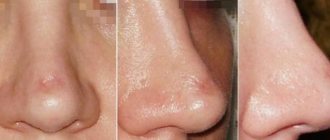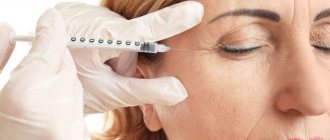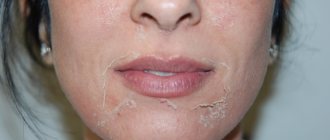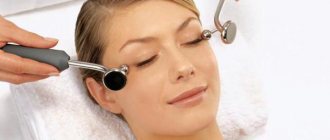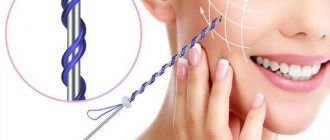Abdominoplasty
Abdominoplasty (tummy tuck) is an operation that is performed to restore the aesthetic appearance of the abdomen; aimed at eliminating stretched skin, removing postpartum stretch marks, local fat deposits, rough scars on the skin, as well as strengthening the muscles of the anterior abdominal wall and emphasizing the waistline.
Indications for abdominoplasty:
- folds of skin and fat, hanging “apron”;
- fat deposits in the abdominal area
- pronounced stretch marks;
- divergence of the rectus abdominis muscles;
- scars in the abdominal area;
- flabbiness and weakness of the abdominal muscles, lack of an aesthetic waist contour;
- umbilical hernia.
Links
| : Incorrect or missing image | To improve this article it is desirable:
|
| Related Articles | History of surgery · Surgical instrument · Surgical treatment · Surgical intervention |
Mammoplasty
Mammoplasty is an operation on the mammary gland to change its size and shape: enlargement, reduction, tightening. Breast augmentation is a simple operation, the essence of which is to install a silicone implant under the breast tissue or under the pectoralis major muscle.
Breast reduction is most often done not for aesthetic reasons, but due to the fact that it is physically impossible to live with such a heavy breast, which leads to various health problems: back pain, spinal deformity, etc.
Indications for the operation:
- Loss of breast volume and shape after pregnancy and lactation.
- Reduction (hypomastia) and absence (amastia) of the mammary glands.
- Condition after removal of the mammary gland (subtotal mastectomy).
- Slight degree of sagging of the mammary glands.
- Asymmetry of the mammary glands.
- Condition after various operations that led to a decrease in the volume of the mammary glands
Types of plastic surgery
Facial plastic surgery can be divided into two categories.
Anti-aging are aimed at combating the manifestations of involutional processes, modeling - at improving appearance by correcting aesthetic imperfections and changing individual facial features. Such a division is to some extent arbitrary, since in practice the surgeon often has to solve two problems during one operation - to change certain features and at the same time remove traces of the past years. These goals do not contradict each other; on the contrary, it is this approach that allows us to obtain the maximum aesthetic result, which completely satisfies the patient and lasts for many years.
Types of plastic surgery aimed mainly at improving appearance by changing individual facial features:
- Rhinoplasty.
- Otoplasty.
- Mentoplasty.
- Mandibudoplasty.
- Painting.
- Frontoplasty (forehead surgery).
- Periorbitoplasty.
- Cheiloplasty.
Types of facial plastic surgery, aimed primarily at correcting age-related changes:
- SMAS-platysmoplasty.
- Blepharoplasty.
- Circular facelift.
- Chin liposuction.
Face lift
Modern face lifting now cannot be called a banal skin tightening. This is a complex, complex operation that affects fairly deep tissues and involves not so much lifting as moving and fixing deep structures in a certain position to achieve a consistently long-lasting result. The intervention is carried out not only on the skin, but also on the subcutaneous tissue, fascia, muscles and periosteum.
In aesthetic surgery, the face is divided into several zones: this is the upper zone, which includes the forehead with eyebrows and the temporal region, upper and lower eyelids; middle zone of the face; lower third and neck.
Places for incisions are selected in inconspicuous areas, in the area of natural folds, which makes postoperative scars invisible to others.
Indications for surgery:
- vertical and horizontal wrinkles on the forehead;
- drooping eyebrows;
- sagging skin;
- nasolabial folds and “marionette folds” (small folds at the corners of the mouth that give the face a mournful expression);
- ptosis (drooping) of the oval of the face;
- the appearance of “jowls”;
- double chin.
HISTORY OF PLASTIC SURGERY: “GOLDEN TIME”
Having mentioned Jacques Joseph, it should be noted that he not only conducted an active practice, but also wrote a scientific work that was published in the 30s of the last century. A detailed description of the methods of aesthetic surgery has become a guide for many doctors practicing in this field. In those years when the world powers and their scientists had already recovered from the First World War, and the outbreak of the Second World War was still far away, medicine, including plastic surgery, experienced a real heyday. Just a few years after the publication of medical publications by Jacques Joseph, the French surgeon Raymond Passot developed methods for tightening sagging facial skin and correcting the mammary glands. He also pioneered the use of sterile horsehair to stitch wounds after surgery to achieve more aesthetically positive results. Until the Second World War came, many other areas of medicine were also actively developing. And the beginning of the war posed new challenges for plastic doctors: they had to treat soldiers from burns and frostbite, eliminate the consequences of fractures and serious wounds, and remove shell fragments from body parts. All forces were involved in such procedures - doctors of different fields and specializations, including plastic surgeons. Such extensive and long-term experience allowed them to accumulate new knowledge and develop new technologies for conducting operations, the possibility of which was previously unthinkable. That is why that period, until the mid-80s of the 20th century, is usually called the “golden time” of plastic surgery. In those years, treatment methods were developed, many of which are actively used by doctors today. This includes complex microsurgical interventions and various corrections of congenital defects in appearance, and a number of ways to eliminate signs of age.
Rhinoplasty
Rhinoplasty is the correction of the cartilage and bone tissue of the nose. The operation allows you to change the size of the nose (reduce, enlarge, widen, narrow), raise or lower it, make the nose more even; solve breathing problems.
Rhinoplasty is performed in two ways: closed and open. Closed rhinoplasty is done through an incision in each nostril from the inside. Open rhinoplasty is performed through an external incision in the skin of the nasal septum. The method is chosen by the doctor depending on individual indications. Indications for surgery:
- congenital or acquired as a result of trauma deformation of the nose;
- impaired nasal function, difficulty breathing;
- aesthetic imperfection of the nose.
Otoplasty
Plastic surgery that allows you to correct the shape of your ears. The surgeon makes a small incision on the back wall of the auricle and corrects the cartilage through it (the auricle consists of thin elastic cartilage), removing its excess, forming a beautiful, regularly shaped auricle adjacent to the back of the head at the desired angle. After this, the correct shape is fixed with special internal sutures. At the end of the operation, cosmetic sutures are applied, which, due to their location, are invisible.
It is possible to perform otoplasty using a laser. When performing laser otoplasty, excess cartilage is removed not with conventional surgical instruments, but with the help of a laser. This method allows you to correct the shape of the auricle in the least traumatic way.
Indications for surgery:
- Malformations of the ears;
- Ear injuries;
- Disproportionality, asymmetry of the ears;
- Protruding ears (protruding ears);
- Too large ears;
- Defect of the earlobes.
HISTORY OF PLASTIC SURGERY: FOUNDERS
The Italian doctor Gaspar Tagliacozzi is considered the founder of plastic surgery in Europe. In 1597, he wrote a treatise on the plastic surgeries he performed and presented it to the scientific community. It talked about the restoration of body parts given by nature, but taken away by fate. About operations performed “not for the sake of pleasing the eyes,” but to give hope to a person who has been injured. Those who familiarized themselves with the works of Tagliacozzi noted that the surgical methods he used, given the weak development of medicine at that time, can be considered revolutionary. But, despite the fact that the Italian surgeon was far ahead of his time, his contemporaries considered such medical intervention to be contrary to the laws of God, and strictly forbade him to practice. This ban quickly spread beyond Italy, outlawing plastic surgery in almost the entire Old World. This led to the fact that until the beginning of the 10th century, not a single reconstructive surgical plastic surgery was performed in Europe, at least not officially. Although operations were still carried out illegally, they were performed by military surgeons, restoring the faces of soldiers damaged in battle. The tense situation on the battlefield did not give them the opportunity to keep records of their medical achievements, and the development of this branch of medicine was, one might say, “frozen” for more than 200 years.
Blepharoplasty
Blepharoplasty or eyelid surgery is an operation that allows you to eliminate excess eyelid skin, its overhang, remove fatty hernias in this area, and solve the problem of drooping corners of the eyes. Also during the operation you can change the shape and shape of the eyes.
Work with the lower eyelid is carried out transconjunctivally: an incision is made along the inner part of the eyelid. When removing excess skin or fatty hernias above the eye, an incision is made in the crease of the upper eyelid.
Indications for surgery:
- Excessively overhanging skin fold on the upper eyelid;
- Fatty hernias (“bags”) under the eyes;
- Wrinkles around the eyes;
- Skin laxity, ptosis.
Types of ptosis and antiptosis
We can distinguish types of ptosis (gravity, prolapse) and antiptosis (factors that prevent prolapse). Of course, the difference is clearly visible when patients previously took care of themselves and visited a cosmetologist. In such patients, the skin is firmer and more elastic, facial wrinkles are less pronounced, and age-related changes will affect them much later. Thus, a 33-year-old patient is sometimes not advised to undergo tissue-conjunctival blepharoplasty, because the skin is already visible in excess in the form of folds under the eyelashes, and will not shrink when fatty hernias are removed. And sometimes, even at 45 years old, it is enough for a patient to undergo tanconjunctival, less traumatic blepharoplasty of the lower eyelids and get an excellent aesthetic result.
The same can be said about a facelift. For some, age-related changes are more pronounced in the lower third and appear quite early (more often in patients with micrognathia - a small lower jaw) and emphasize age. For some people, the drooping of the upper third of the face (forehead, sad eyebrows) comes to the fore, so by doing blepharoplasty with an endoscopic lift of the forehead and eyebrows, you can get an excellent result: minus 10 years, an open look, beautiful high eyebrows. Such operations are also performed at a young age in order to give femininity and expressiveness to the face. As for the circular lift, it is better to do this operation earlier.
Already at the age of 45, patients notice what they call “the contour has swum”, there is no definition in the chin, a tired, sad face. Of course, everything depends on the features of the facial anatomy, the condition of the skin and the perception of beauty of the patients themselves. At 38-40-43, if the skin turgor is still good, there were no significant fluctuations in weight, an endoscopic facelift (middle and upper thirds) will give a good rejuvenating effect. It is fundamentally different from the classic circular one. After all, there is no excess skin yet and the skin is not cut off; the soft tissues are redistributed as a single block upward in a vector opposite to the forces of gravity. The same effect can sometimes be achieved by thread lifting.
Thus, today, plastic surgery is not a template routine surgery according to books and protocols, it is a clearly individual approach to each patient.
Liposuction
Liposuction is an operation that can remove excess fat from certain areas of the face and body.
Liposuction is most effective for removing fat deposits on the buttocks, hips, waist and chin. The surgeon makes a small incision and inserts a narrow tube through which subcutaneous fat is pumped out using a special device. The operation is low-traumatic, and there are practically no scars left after it.
Indications for surgery:
- The need for local removal of subcutaneous fat.
Advantages of face and neck plastic surgery at SM-Plastic
The plastic surgery clinic "SM-Plastic" offers facial plastic surgery services in Moscow. Waiting for patients here:
- Performing all types of surgical plastic surgery of the face and neck of any complexity.
- European level equipment.
- Qualified surgeons with practical experience of 15 years.
- Thorough preparation for the operation, consultations with doctors in 30 areas.
- Safe plastic surgery: facial correction through rhinoseptoplasty, endoscopic lifts.
- High-quality suture materials.
- Comfortable conditions for a hospital stay.
- Optimal cost of operations.
In order to undergo face and neck plastic surgery at SM-Plastic, you must make an appointment using the feedback forms on the website or by phone: +7 .
Our advantages
Experienced surgeons
Modern equipment
Free consultation
Affordable prices
European service
